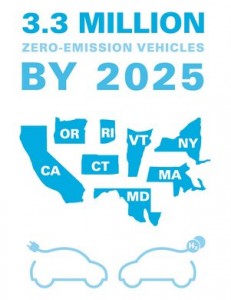 In October 2013, eight states signed an agreement to support bringing 3.3 million zero emission vehicles (ZEV) to their roads by 2025. Led by California, governors from seven other states also signed a memorandum of understanding to do so – Connecticut, Maryland, Massachusetts, New York, Oregon, Rhode Island, and Vermont. At that time, ZEVs were to include battery-electric vehicles, plug-in hybrid-electric vehicles, and hydrogen fuel-cell-electric vehicles – and could be used in passenger cars, trucks, and transit buses.
In October 2013, eight states signed an agreement to support bringing 3.3 million zero emission vehicles (ZEV) to their roads by 2025. Led by California, governors from seven other states also signed a memorandum of understanding to do so – Connecticut, Maryland, Massachusetts, New York, Oregon, Rhode Island, and Vermont. At that time, ZEVs were to include battery-electric vehicles, plug-in hybrid-electric vehicles, and hydrogen fuel-cell-electric vehicles – and could be used in passenger cars, trucks, and transit buses.
More recently, the California Air Resources Board, the agency implementing the ZEV rules in the state, has been leaning toward battery electric and hydrogen fuel cell vehicles while downplaying plug-in hybrid electric vehicles. California has a goal of cutting its carbon emissions 80% from 1990 levels by 2050. Vehicles would need to be fully electric, and plug-in hybrids wouldn’t cut it, said CARB Chairman Mary Nichols.
Here are my thoughts on where this trend could be heading…………..
There might be a way to realistically compromise. Ford, General Motors, Honda, and Toyota have filed a complaint with CARB arguing that vehicle owners are more likely to accept and adopt plug-in hybrids to relieve their range anxiety – and these vehicles are more likely to be accepted in the short run. These automakers pointed to a 2014 analysis by the US Department of Energy’s Idaho National Laboratory to make their case. “Researchers crunched data from 21,600 EVs and plug-in hybrids and found that Volt owners were averaging 9,112 e-miles per year, just shy of Leaf owners’ 9,697 e-miles — even though the Volt can go only half as far before running out of battery power,” according to Automotive News. Dan Sperling, a CARB member and director of the Institute of Transportation Studies at the University of California-Davis, tends to agree with automakers on this point. He would rather see two plug-in hybrids on the road than one all-electric vehicle. Taking a more flexible approach is the way to go, according to Sperling. The state is likely to see far more “e-miles in 2030” by supporting plug-in hybrids than would be seen with pure EVs.
Next-gen batteries are still two-to-three years away. Automakers are working with major battery suppliers to offer electric vehicles that are more affordable to consumers and can go at least 200 miles on a single charge. It’s expected to be two-to-three years from now for that to be here, but it could take longer – and there are only so many Tesla models that can go 265 or more miles out on the roads.
Commercial vehicles need extended range. While some vehicles like drayage trucks at ports might be ideal for battery electric and hydrogen fuel cell, many of them will be on roads for hundreds of miles per day and will need to get there. Trucks being tried out in agribusiness in the Central Valley of California are tipping toward plug-in hybrid systems.
Dual fuel and plug-in hybrid could be a good way to go. What if you were to drive a bi-fuel CNG Chevrolet Impala that was also built on the Voltec plug-in hybrid drivetrain? That would offer the driver an opportunity to power the car on natural gas (which emits about 25% less greenhouse gas than a gasoline-engine vehicle), battery power (zero percent emissions) and then have gasoline left over to power the car to take away range anxiety. That might be ideal for fleets that worry about having drivers stuck out on roads. In the next few years, there will be a lot more clean fuels out there, including dimethyl ether (DME), biogas (renewable natural gas), algae biofuel, biodiesel, and renewable diesel. A plug-in hybrid that also runs on a clean fuel would be able to offer extended range and reduced emissions – meeting all the targets.
OEMs are leaning toward plug-in hybrids. Battery electrics are doing better than plug-in hybrids in US sales right now, but that tends to be weighted toward the Nissan Leaf, Tesla Model S, and the BMW i3. If you look at the product pipelines for major automakers, most of the models coming out are plug-in hybrid. The challenge here will be picking up their sales volume, which will need incentives and more public education about charging and ownership cost. In the long run, plug-in hybrids/extended range electric vehicles appear likely to equal or surpass battery electric and hydrogen fuel cell vehicle sales numbers.
CARB will probably tip in this direction. Automakers are pushing for it and Mary Nichols did acknowledge compromise may be there. Battles between major OEMs and California reached a stalemate in the 1990s, and both automaker executives and government officials in Sacramento are taking a more moderate approach this time around. Nichols said she is wrestling with the best way to reach the state’s emissions goal. “I don’t know where you would find a better example anywhere in the world,” Nichols said, “of a public deliberating body struggling with a really big issue.”



